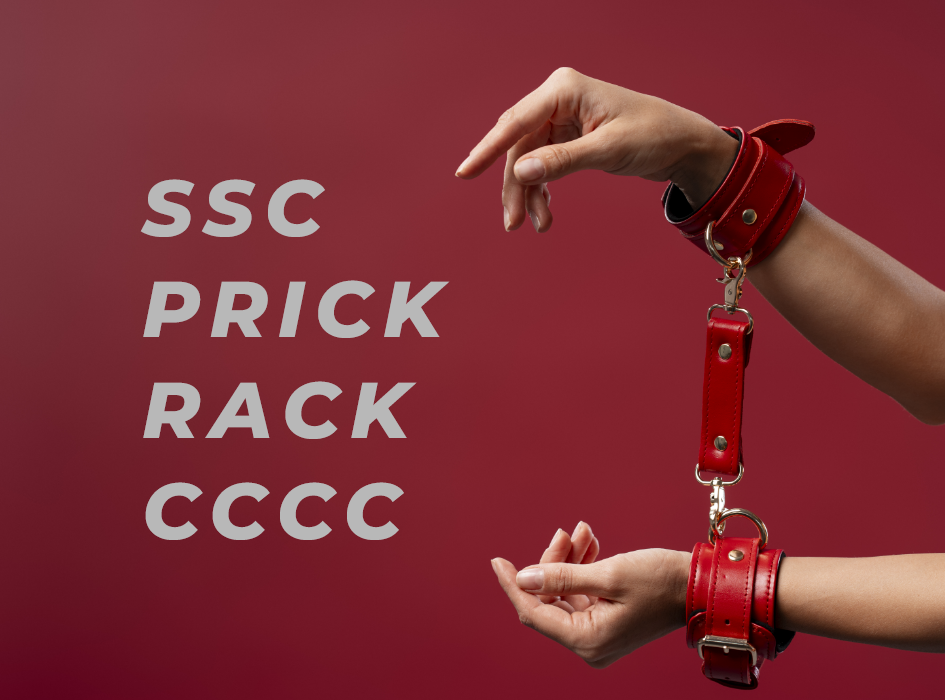Power Exchange Dynamics: Exploration of Different Types of Power Exchange Relationships, Including Dominant/Submissive and Switch Roles
Power exchange dynamics within relationships are a fascinating and multifaceted aspect of human interaction, particularly in the context of BDSM. These dynamics involve the consensual transfer of power and control from one partner to another, creating a unique and profound connection. This blog will explore different types of power exchange relationships, including dominant/submissive roles, switch roles, and other variations.
Understanding Power Exchange Dynamics
Power exchange in relationships is about more than just control and submission; it's a complex interplay of trust, communication, and mutual satisfaction. The foundation of any power exchange relationship is consent. Both partners agree on the terms and boundaries, ensuring that the dynamic is safe, sane, and consensual.
Power exchange can manifest in various forms, from the subtle to the overt, and can be integrated into everyday life or reserved for specific scenarios. The key is that both partners find fulfillment and joy in the roles they assume.
Dominant/Submissive Dynamics
The dominant/submissive (D/s) dynamic is one of the most well-known forms of power exchange. In this relationship, one partner (the dominant) takes control and makes decisions, while the other partner (the submissive) yields control and follows the dominant's lead.
Dominant Roles
The dominant partner, often referred to as the Dom (or Domme for a female dominant), assumes the role of the leader. This role involves responsibility, care, and the ability to guide the submissive partner. Dominants must be attuned to their submissive's needs, limits, and desires, ensuring that the power exchange is fulfilling and respectful.
Dominants can exhibit various styles, from nurturing and protective to strict and authoritative. Some dominants enjoy creating detailed protocols and rituals, while others prefer a more spontaneous approach. The key is that the dominant provides a safe and structured environment for the submissive to explore their submission.
Submissive Roles
The submissive partner, or sub, willingly gives up control, finding pleasure and satisfaction in serving and obeying their dominant partner. Submission is not about weakness or inferiority; it is a consensual and empowering choice to surrender control. Submissives often find liberation in their role, experiencing deep emotional and psychological fulfillment.
Submissives can also exhibit different styles, from obedient and passive to bratty and playful. Some enjoy strict rules and discipline, while others thrive on more relaxed and affectionate dynamics. The important aspect is that the submissive feels valued, respected, and secure in their role.
Dynamics and Protocols
Dominant/submissive relationships can vary greatly in terms of structure and intensity. Some couples incorporate power exchange into their daily lives, establishing protocols for behavior, communication, and tasks. Others may reserve their D/s dynamics for specific scenes or play sessions, maintaining a more conventional relationship outside of these moments.
Protocols can range from simple gestures, such as addressing the dominant with a specific title, to elaborate rituals involving dress codes, speech patterns, and behavioral expectations. These protocols reinforce the power exchange and deepen the connection between partners.
Switch Roles
Switches are individuals who enjoy both dominant and submissive roles, often alternating between the two depending on their mood, partner, or situation. Switches bring a unique perspective to power exchange dynamics, as they understand the desires and motivations of both roles.
The Fluidity of Switch Roles
Switches embody the fluidity of power exchange, finding satisfaction in the versatility of their interactions. They may switch roles within a single relationship or have different dynamics with different partners. This adaptability allows for a rich and varied exploration of power and control.
For switches, the ability to experience both sides of the dynamic can lead to a deeper understanding of their own desires and those of their partners. This duality can enhance empathy, communication, and mutual satisfaction within the relationship.
Challenges for Switches
Switches may face unique challenges, such as finding partners who are comfortable with their versatility or navigating their own shifting desires. Open communication is crucial for switches, as they need to express their changing needs and negotiate roles with their partners.
Being a switch can also involve navigating societal perceptions and stereotypes. Some people may mistakenly view switches as indecisive or inconsistent, but in reality, switches are individuals who embrace a broader spectrum of experiences and emotions.
Exploring Other Power Exchange Dynamics
Beyond the dominant/submissive and switch roles, there are numerous other power exchange dynamics that couples can explore. Each dynamic offers a unique way to connect, communicate, and find fulfillment in the relationship.
Master/Slave Dynamics
Master/slave (M/s) dynamics represent a more intense and structured form of power exchange. In these relationships, the dominant (Master or Mistress) has comprehensive control over the submissive (slave), often extending to various aspects of the slave’s life.
M/s relationships are built on profound trust and commitment, with the slave willingly surrendering autonomy to their Master or Mistress. The dynamics can include detailed protocols, contracts, and rituals that define the nature of the relationship.
Caregiver/Little Dynamics
Caregiver/little (CGL) dynamics focus on nurturing, protection, and a sense of innocence. In these relationships, one partner (the caregiver) assumes a nurturing, parental role, while the other partner (the little) embraces a more childlike, dependent role.
CGL dynamics can involve activities such as age play, where the little engages in behaviors and interests associated with a younger age. The caregiver provides guidance, comfort, and structure, creating a safe and supportive environment for the little.
Primal Dynamics
Primal dynamics tap into raw, instinctual behavior, emphasizing the animalistic aspects of power exchange. In primal play, partners engage in physical and emotional interactions that mimic the behaviors of animals. This can include growling, wrestling, and other forms of rough, passionate play.
Primal dynamics focus on the visceral connection between partners, stripping away societal norms and embracing the primal instincts within. These interactions can be incredibly intense and freeing, allowing partners to connect on a deeply elemental level.
Owner/Pet Dynamics
Owner/pet dynamics involve one partner (the owner) taking on the role of a caretaker, while the other partner (the pet) assumes an animalistic persona. This dynamic can include behaviors such as pet play, where the pet mimics the actions and mannerisms of a chosen animal (e.g., puppy play, kitten play).
Owner/pet dynamics often include elements of training, discipline, and reward, creating a playful and structured environment. The connection between owner and pet can be nurturing, affectionate, and deeply satisfying for both partners.
The Importance of Communication and Consent
Regardless of the specific power exchange dynamic, communication and consent are paramount. Partners must engage in ongoing, open, and honest conversations about their desires, boundaries, and experiences. This ensures that the power exchange remains consensual, respectful, and fulfilling for both parties.
Establishing clear boundaries and safe words is crucial for maintaining safety and trust within power exchange relationships. Safe words provide a way for partners to communicate discomfort or the need to pause an activity, ensuring that everyone feels secure and respected.
The Emotional and Psychological Impact of Power Exchange
Power exchange dynamics can have profound emotional and psychological impacts on both partners. For many, these relationships offer a sense of liberation, trust, and intimacy that is difficult to achieve through conventional interactions.
For Dominants
Dominants often experience a deep sense of responsibility and fulfillment in their role. The act of guiding, protecting, and caring for their submissive can create a powerful bond and a sense of purpose. Dominants may find satisfaction in the trust and admiration their submissive places in them, as well as in the control and authority they wield.
For Submissives
Submissives often find liberation in surrendering control and embracing their submissive nature. The act of submission can provide a sense of release, allowing them to let go of stress and societal expectations. Submissives may experience profound emotional and psychological satisfaction from pleasing their dominant and adhering to established protocols.
For Switches
Switches benefit from the versatility and fluidity of their role. The ability to experience both dominance and submission can lead to a more comprehensive understanding of their own desires and those of their partners. This duality can enhance empathy, communication, and mutual satisfaction within the relationship.
Challenges and Considerations
Power exchange dynamics are not without their challenges. Miscommunication, unmet expectations, and boundary violations can occur, leading to emotional distress and relationship strain. It is essential for partners to approach these dynamics with care, patience, and a willingness to learn and grow together.
Navigating Societal Perceptions
Societal perceptions and stigmas surrounding power exchange relationships can also pose challenges. Partners may face judgment or misunderstanding from those who do not understand or accept their dynamics. It is important for individuals in power exchange relationships to build a supportive community and seek resources that affirm their experiences.
Balancing Power Exchange with Everyday Life
Integrating power exchange dynamics into everyday life can be complex, especially for those who maintain a 24/7 dynamic. Balancing the roles and responsibilities of daily life with the demands of a power exchange relationship requires careful planning, communication, and flexibility.
Conclusion
Power exchange dynamics offer a rich and varied landscape for exploring intimacy, trust, and mutual satisfaction. Whether through dominant/submissive roles, switch dynamics, or other power exchange relationships, partners can find profound fulfillment and connection. The key to a successful power exchange relationship lies in communication, consent, and a deep understanding of each other's needs and desires.
By embracing these principles, partners can navigate the complexities of power exchange dynamics and create a relationship that is both deeply satisfying and profoundly intimate. Whether you are new to power
Related posts
-
Acronyms of BDSM : A Look at SSC, RACK, PRICK and CCCC
BDSM acronyms have emerged and been debated over a time as away to protect BDSM......
-
Is It Common to Lose an Erection When Wearing a Condom?
Have you ever been ready to go, but lost your erection when putting on a......
-
Is the Idea of a Cuckquean Rooted in Myth or Real-life Practices?
A cuckquean is a woman whose husband is unfaithful, often with her knowledge and sometimes......


